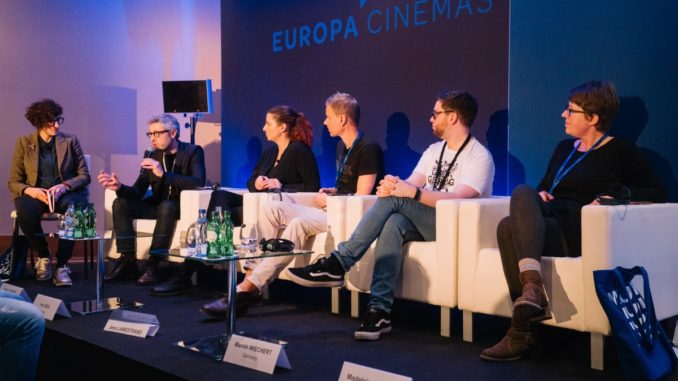
On Saturday morning, the participants could choose between two enthralling workshops, one of which on Digital Marketing Strategies: How Do Films and Venues Stand Out and Get Noticed? moderated by Irene Musumeci, Film Marketing Manager/ Exhibition at Curzon Artificial Eye in the UK. The workshop was the occasion to reflect on how to make the most of the relations with the distributors, be efficient on social networks, and be inclusive in reaching out to young people and diverse communities by listening to the audience needs.
Thierry Delpit, CEO of Cine Society, France, and co-creator of CINEGO, a delivery system of DCPs, kicked off the discussion with figures highlighting the presence of cinema goers on social network. 80% of French cinema goers are on Facebook and very often other social networks as well and they primarily use these sources to get the information on films. That being known, cinemas marketing are in competition with many other entertainment industries, so there is a real necessity to connect exhibitors and distributors strategically.
Having the right communication material, made easily available, the sponsoring of post, the sharing of essential info should be made available on the future platform Cine Society.
Jens Lanestrand, Swedish exhibitor at the non-profit organisation Biografcentralen, Sweden then introduced DGM Digital Marketing for Cinemas a 100% 12-month access online training for exhibitors with hands on exercises, assignements to change the way one works. Irini Siga, founder and curator of DMC Training Programme Marketing and Communication Manager, explained how a full online programme was designed. An international release is planned for 2020. She detailed what can be found on the website insisting that the first thing to do is to have a clear idea of who your audience is.
Module 1. Tools to analyse your business
Module 2. How to optimize your website
Module 3. Relevant content
Module 4. How to measure results
It was then Marvin Wiechert‘s turn to share his experience as Digital Marketing Manager at Yorck Kinogruppe in Germany. First of all, Marvin gave his definition of the different generations which he considers in terms of how they are connected to Internet : Pre-internet people, First-Internet people, Full-internet people, post-internet people = and they approach the Internet accordingly. What can be sure is that if young people watch screens all day, it doesn’t mean they focus on empty content therefore, in the Greta Thunberg era, it is a good strategy for exhibitors to look at the issues teenagers care about. Yorck Kino is careful to have a distinct voice and tone on Instagram which they maintain so it sounds like one person not one “brand”.
Marvin’s team is attached to be relevant enough for young people to take notice. The results are great, the segment 18-24 segment is growing fast. Distributors funded campaign enable them to create ads on Instagram on films which are deemed to deserve campaign (ex. Parasite, use of memes which arose as soon as the films was shown at Cannes Film Festival). To complete this work, Yorck also practices Loyalty digital campaign, with targeted ad and newsletters for instance.
Madeleine Probst, programme producer at Watershed Cinema, UK told about the increasing social role at her cinema by engaging with the city and the young people who live there. Eventization, content creation with young people is practiced for instance.
Their pioneering “5 pound offer” was a first step, removing the barrier of price and it was a user focused campaign ! Then the way they built their offer for young people is by looking first at what they liked : old restored films like Old Boy, local productions like Bait, genre films, short films, documentaries. The starting point was also to be found in what young people expect from the cinema : they are looking for mentors, equipment, space to network, develop their talent, content creation. Madeleine envisions it as a two-way street since some qualified young people are then employed at Watershed. The cinema works with associations, distributors, influencers when they’re struggling on how to find audience. Creation of tee-shirts to involve young people, invitation to previews, Flashmobs, dancing/boxing, graffiti etc are examples of initiatives at Watershed.
« It’s about getting people through the door and then making your space welcoming » says Madeleine, “looking for authenticity, emotion, interactions“.
Engagement is a long journey.
Irene noted that the presentations ranged from complex technology to complex human interaction and community. Thierry Delpit commented on the importance to provide right content at the right time for exhibitors, on his intent to facilitate it especially for cinemas with fewer means and staff. All the more so as for distributors, the community of exhibitors is very valuable and relevant.
Irini reminded the careful audience that the main thing is to dig deep into your audience, what they need, and focus on target groups behaviours. Marvin agreed and added on how important it is not to try and reach « everyone » and indeed first know your audience. His advice is to “run ahead with your guts”. Madeleine addressed exhibitors who do not necessarily have a community manager, urging them to collaborate with associations, to find inspired people in their team etc. to make great digital campaign.
All the speakers concur in saying that it is best to build personalized campaigns related to one’s venue personality, identity even though it is sometimes difficult to convince the distributors it is worth it. Smaller venues may find help and resources to achieve it, as illustrated in this workshop.
The workshop ended on the idea that both digital and physical spaces should feel warm and personal, and that there is indeed a continuity between the social media experience and the actual experience at the cinema theatre.
Photographs courtesy of Joana Linda.
Charlotte Wensierski
